Florence to discover: anecdotes and curiosities that nobody knows
Between the windows of palaces, bridges and churches in search of stories that amaze
More than doors, intended for the passage of people and goods, the window has always been a symbol. The eye of the soul for painters, or of sacredness, intended as divine light filtering through Gothic windows. With real glass as the Romans did or waxed canvas, as Raphael depicts in the Madonna dell’Impannata. But always a view on the world, or on the divine. Michelangelo must have thought of this when Leo X had him enclose the loggias of the family palace - Palazzo Medici Riccardi in via Larga.
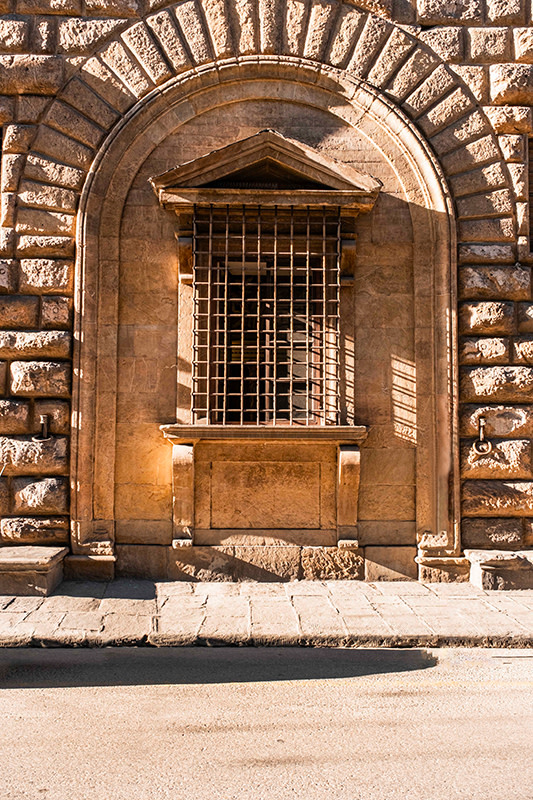 Palazzo Medici Riccardi
Palazzo Medici RiccardiHe created windows with great sills supported by two stone scrolls. Kneeling windows, Giorgio Vasari immediately called them with his ability to sum up art and history in a few words. Of course, kneeling, as if they were altars. With variations of all kinds. When he built the Casino di San Marco in 1568, a sort of laboratory for experiments in alchemy for his saturnine client, the Grand Duke Francesco I, the eclectic Mannerist architect and inventor, Bernardo Buontalenti, created kneeling windows, but animated them with monkeys and various monsters emerging from shells. All allusions to the magical aspiration of the elitist workshop that had once been the Garden of San Marco.
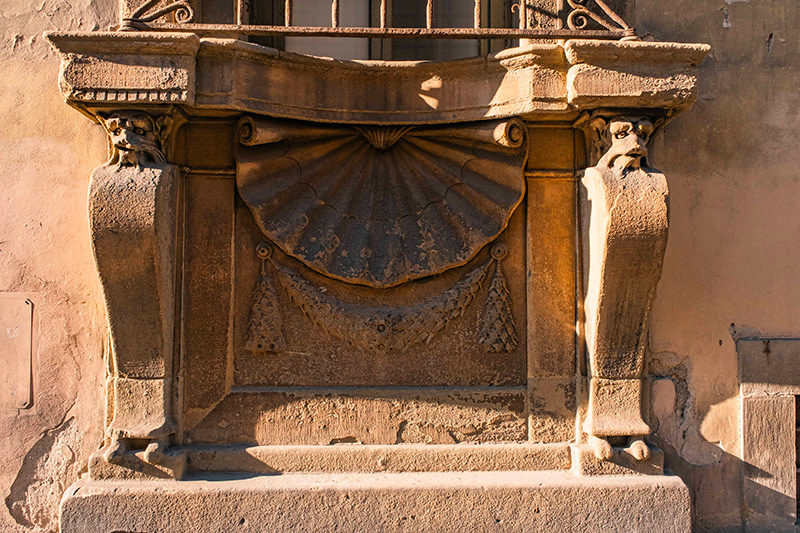 Buontalenti’s kneeling window decoration on the façade of Palazzo Buontalenti
Buontalenti’s kneeling window decoration on the façade of Palazzo Buontalenti Also kneeling but enormous, are the windows on the ground floor of Palazzo Pitti. It is said that the imposing palace commissioned by Luca Pitti also had to have windows larger than the portals of Palazzo Medici. Difficult to establish, given that those were modified by Michelangelo, while firstly Ammannati, then Buontalenti and his nephew Giulio Parigi who expanded the palace to accommodate Cosimo II’s large family, had a hand in Pitti.
But while the Medici expanded their houses at will, not everyone could afford to do so. So when there were children, it was preferred to open small windows protected by strong grilles below the main ones to allow the youngsters to look out onto the street. Today there are few left - at No. 8 Via Borgo Santa Croce where the Vasari house is, in Via Del Moro, in Borgo San Frediano and a few others.
If children could peek at the world through the grilles, there were those who could never do so again. This is the story of the walled window of Palazzo Pucci. The powerful family, a long-time Medici ally, suffered a setback in 1559 when Pandolfo Pucci, a scion as rich as he was dissolute, was expelled from the city for immoral behaviour. Pandolfo decided to take revenge and organized a conspiracy against Cosimo I. He hired a sniper who was supposed to shoot the duke from that very corner window when he passed by on his way to the Church of the Santissima Annunziata. The plot was discovered ahead of time and Pandolfo was hanged and left dangling from the Bargello, while the window of the conspiracy was walled up and never reopened, as can still be seen today on the corner of via de’ Pucci and via de’ Servi.
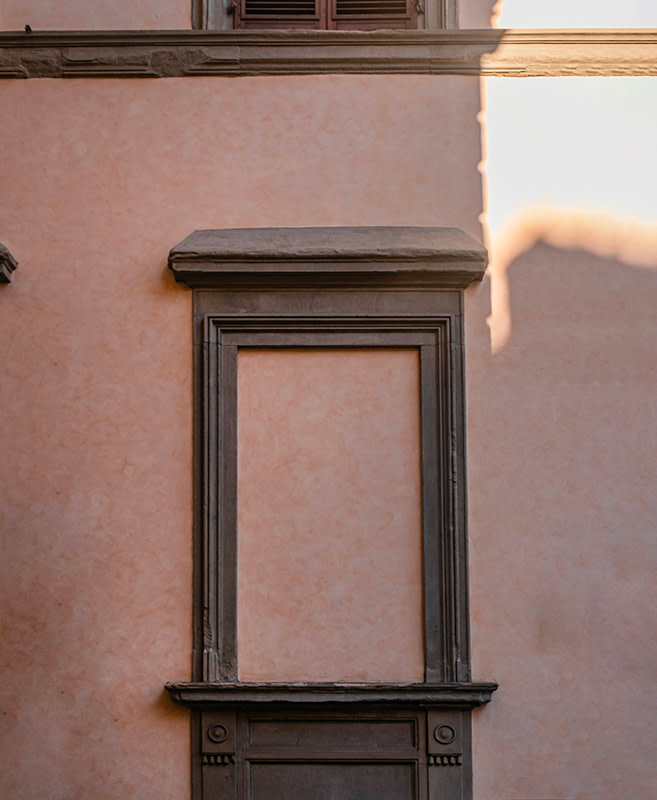 The walled window of Palazzo Pucci
The walled window of Palazzo PucciHowever, the last window on the right on the first floor of Palazzo Budini-Gattai (formerly Grifoni), in Piazza Santissima Annunziata, has never been closed. It is said that the devoted bride of a Grifoni who went off to battle, vowed to wait for him at that window. He died, but she refused to give up, and every time someone tried to close it, lightning and whirlwinds shook the building. So it remained open. Forever.
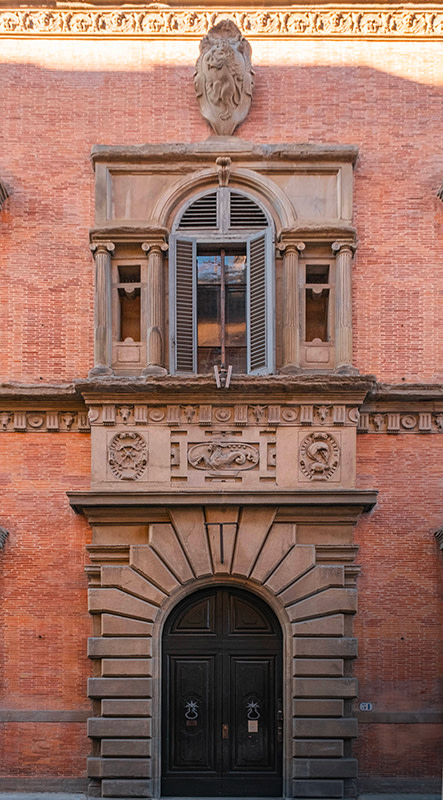 Palazzo Budini Gattai
Palazzo Budini GattaiAnd Jacopo Grifoni, secretary to Cosimo I, entered history when in 1574 he had Baccio d’Agnolo build an elegant palazzo with central serlian windows (an architectural element comprising a larger, arched centre window with flanking windowssurmounted by an architrave, like a stylized letter omega) which on the side facing the church, include the Grifoni emblems and coat of arms, and on the other facing Via dei Servi, a tribute to Cosimo with the Capricorn and a turtle with a sail, emblems linked to his famous motto Festina lente, make haste slowly.
As an exposed red brick building, the Budini-Gattai caused a bit of a sensation, but certainly not like that of the Bartolini Salimbeni family in Piazza Santa Trinita. The task was again given to Baccio d’Agnolo – skilled, but much criticized by the Florentines - who created windows (later called guelphs) divided into four sections, embellished with niches, a frieze with three poppies and the family motto Lest we sleep. In this regard, it is said that one night, awaiting the arrival of a shipment of silk, this family of astute merchants invited their rivals to dinner, at the end of which they drugged their wine with opium. So the next morning while the others slept, they were the first to purchase the best goods. Legend? Perhaps, but the facade is full of subliminal messages.
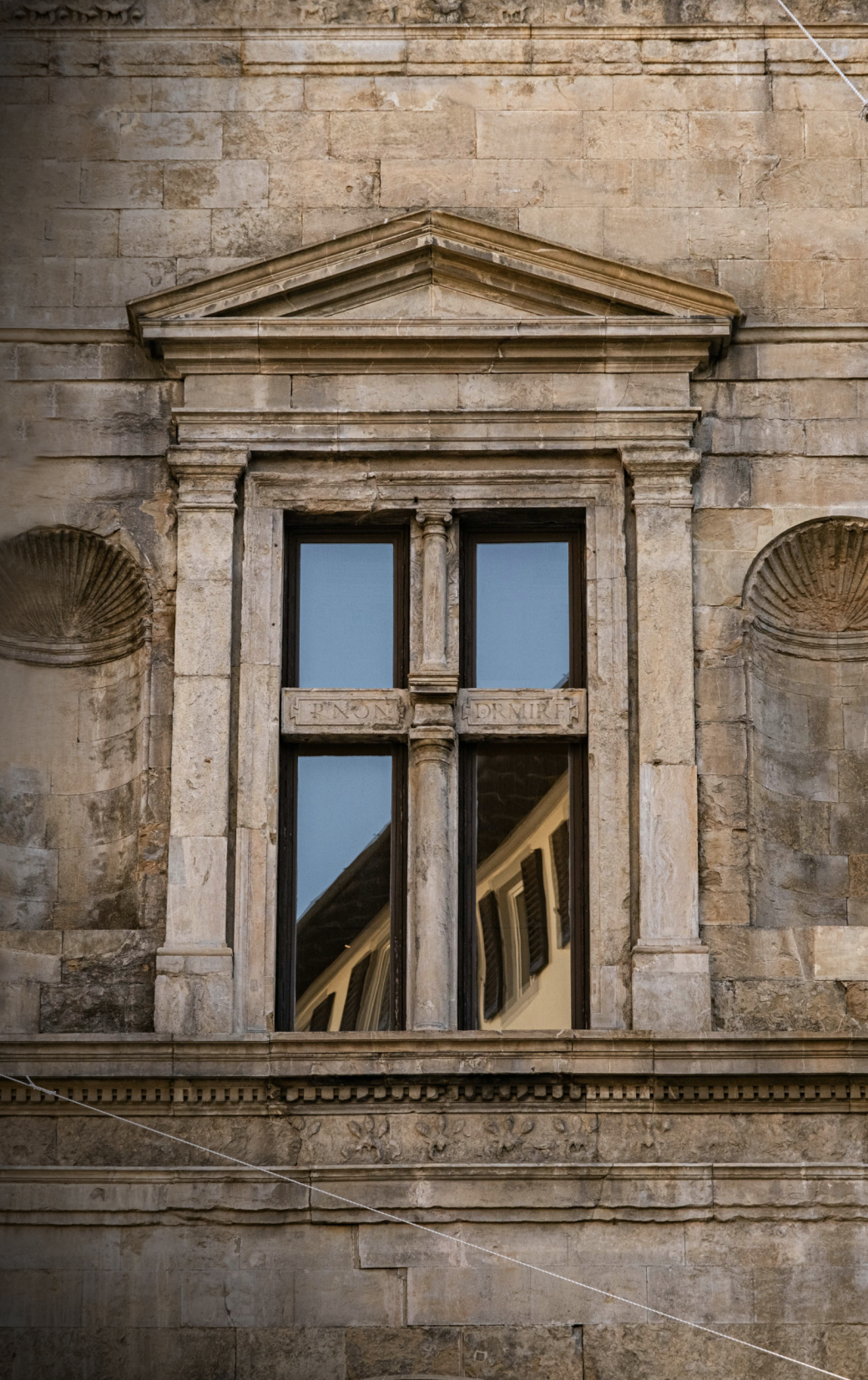 Palazzo Bartolini Salimbeni
Palazzo Bartolini SalimbeniBaccio d’Agnolo also added his own, criticising is easier than imitating, perhaps to issue a warning. The palazzo was too “Roman” in style for the restrained Florentines, who had in mind the sobriety of Palazzo Rucellai, built by Bernardo Rossellino in the mid-1400s to a design by Leon Battista Alberti with flat ashlar and mullioned windows. Alberti removed the pointed arch from the gothic mullioned window and transformed it into a play of concentric all-round arches, which are contained between pilasters and capitals of the various orders. He combined Roman antiquity with Renaissance style that he was initiating.
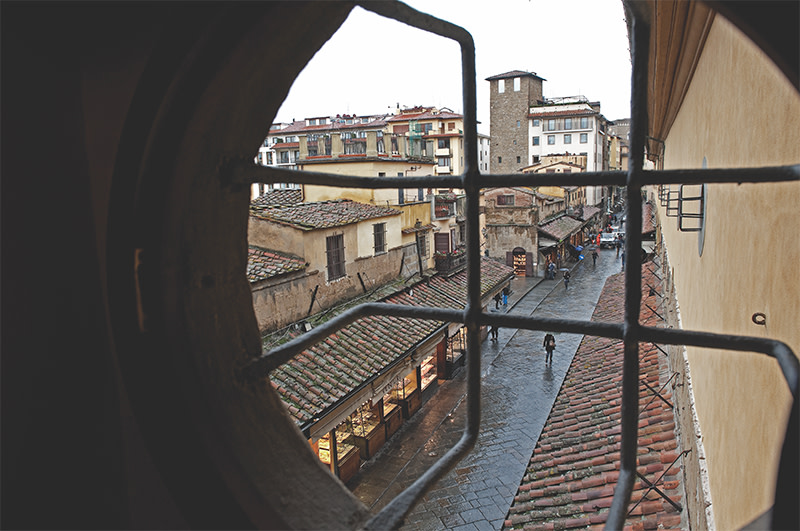 The view on the inside of the Ponte Vecchio from one of the little round windows
The view on the inside of the Ponte Vecchio from one of the little round windowsThe result is perfect harmony. The same cannot be said of the three windows on the west side of the Ponte Vecchio. Although popular legend had them knocked into a viewing gallery especially for Hitler, the opening was actually made for Vittorio Emanuele II in the aftermath of the 1859 plebiscite, with which Tuscany joined the nascent Kingdom of Italy. Until then, anyone crossing the Vasari Corridor could only observe Florence through the 73 smaller-sized (so non-panoramic) windows that pierce the Vasari Corridor at eye level on both sides – bigger square ones overlooking the river and smaller round ones facing the road and the walkway of Ponte Vecchio and covered by grilles.
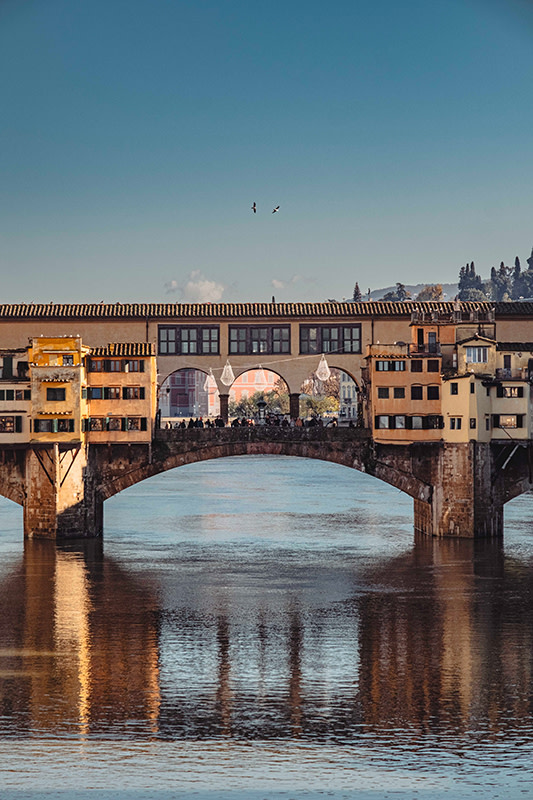 The enlarged windows of Ponte Vecchio
The enlarged windows of Ponte VecchioIt is said the latter were used in the Medici era, by the Grand Duke and his circle of courtiers to spy on the Florentines without being seen. Another curiosity - which we will soon see again when the Vasari Corridor is reopened - is that at a certain point, inside there is a round window with an iron grille and a balcony located on the counter-façade of the Church of Santa Felicita. From here the Medici attended mass, being able to count on a private and privileged position, which allowed them to avoid the danger posed by mixing with the common people.
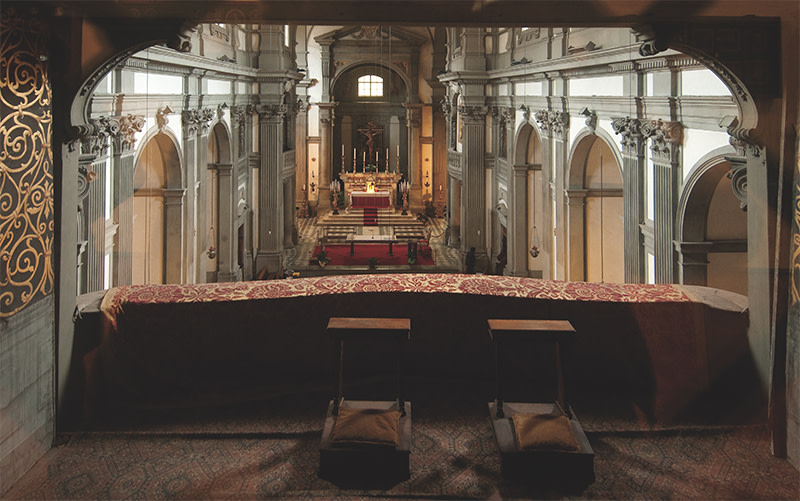 La vista sulla chiesa di Santa Felicita dal Corridoio Vasariano (ph. Lorenzo Cotrozzi)
La vista sulla chiesa di Santa Felicita dal Corridoio Vasariano (ph. Lorenzo Cotrozzi)Arnolfo di Cambio would have imagined anything but the closure of his marvellous mullioned windows, tall and narrow, they were real pieces embroidery. But Santa Maria del Fiore was enlarged during the 14th century and those three windows on each side were now obsolete. In fact, today they are only visible from the outside. And Strozzi must have been really thirsty for light when, in the 18th century, opposite Santa Maria Maggiore, he built Palazzo del Centauro, so called for the statue by Giambologna situated there, at the Canto dei Carnesecchi, behind the gloomy Ghetto. Better known today as the Palazzo of 100 Windows, the kneeling windows have been replaced by shop windows and the building has lost its originality, but the windows remain, a few less than a hundred.








